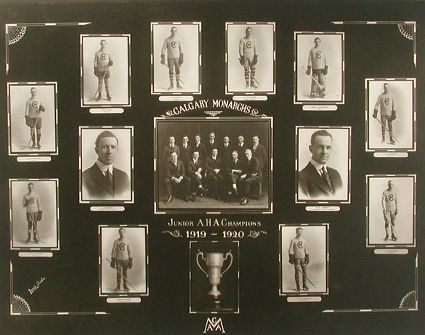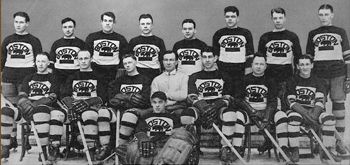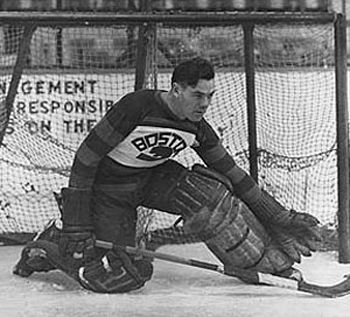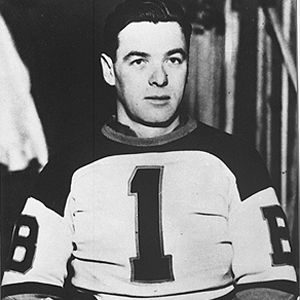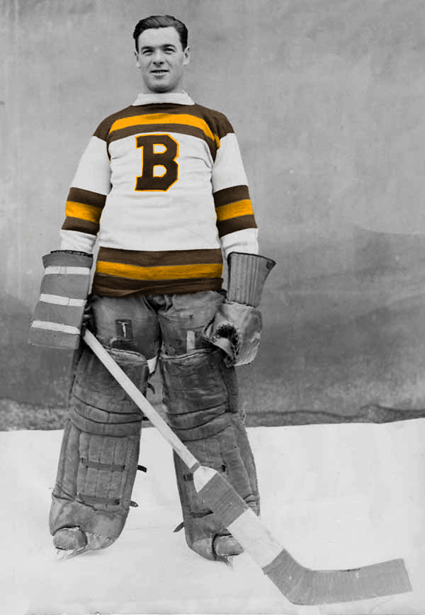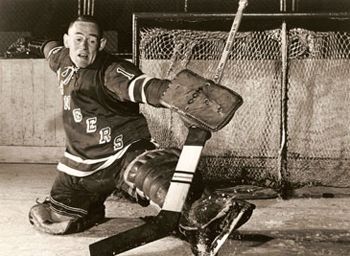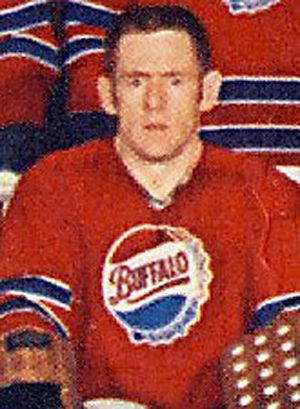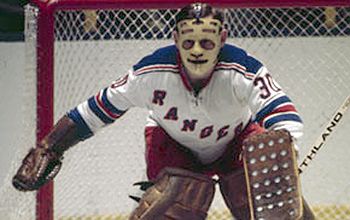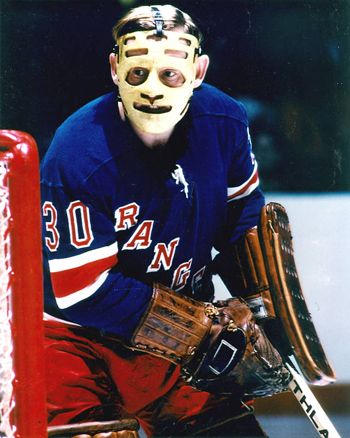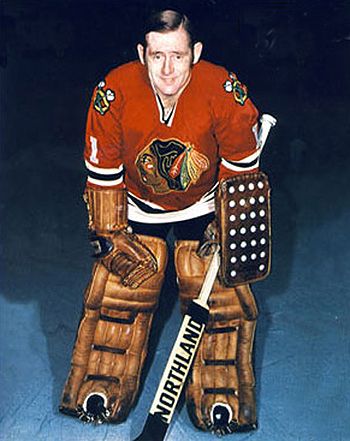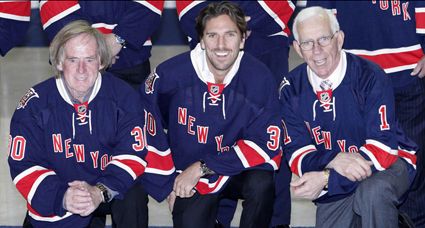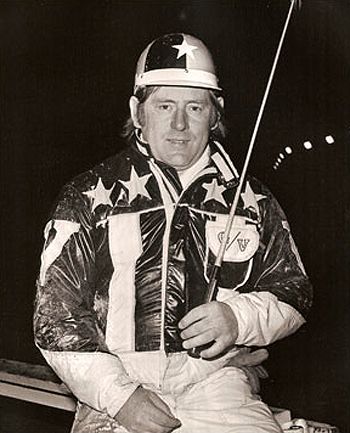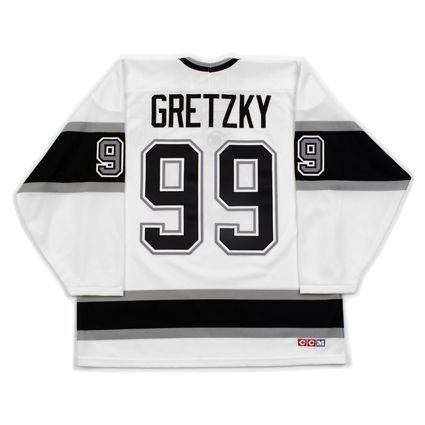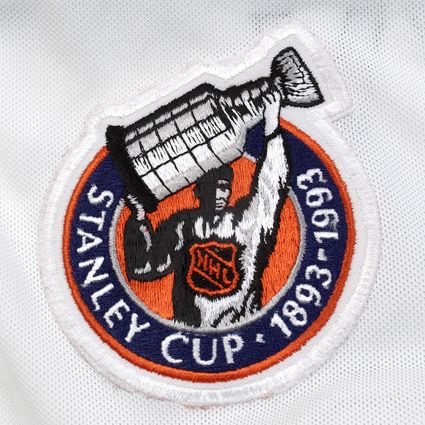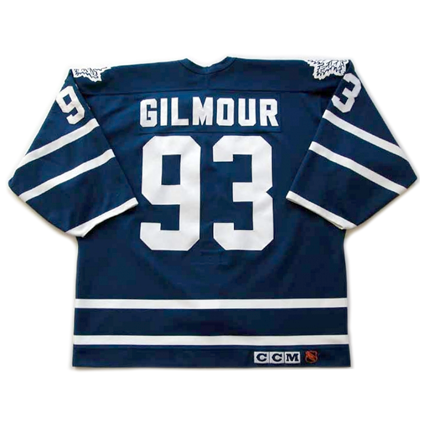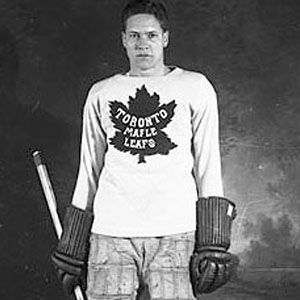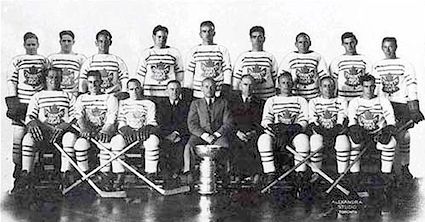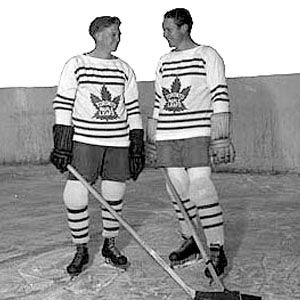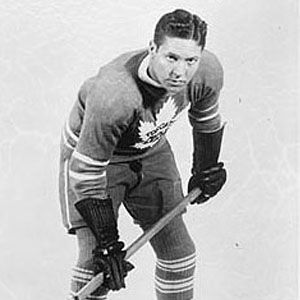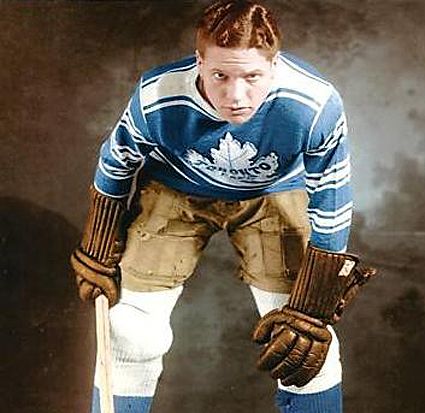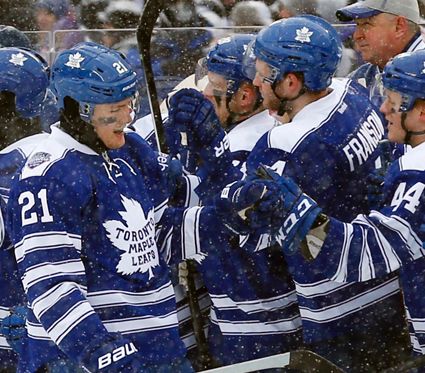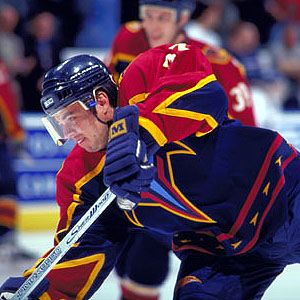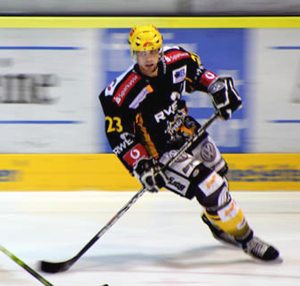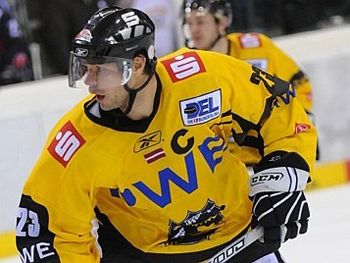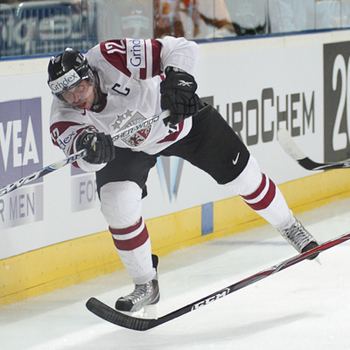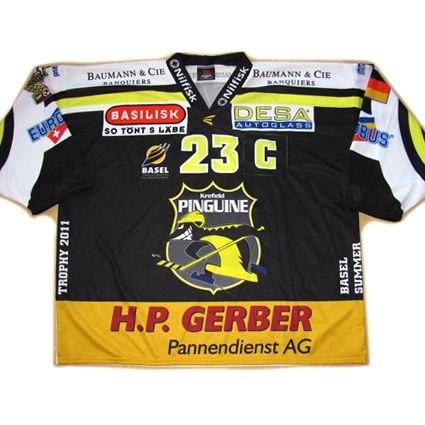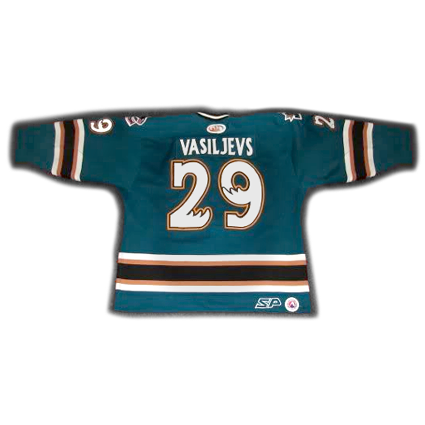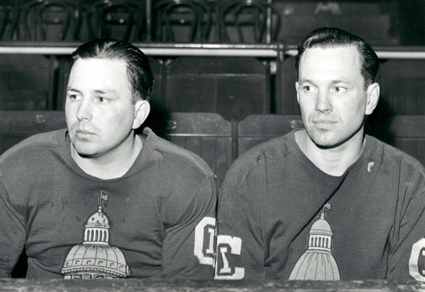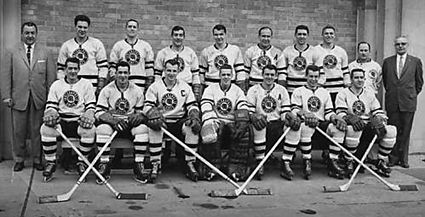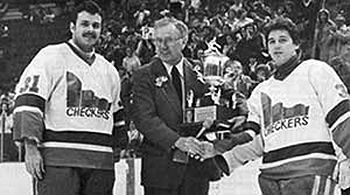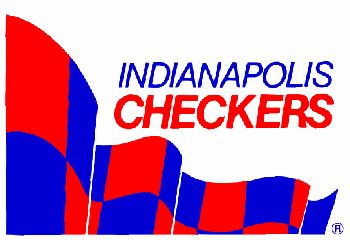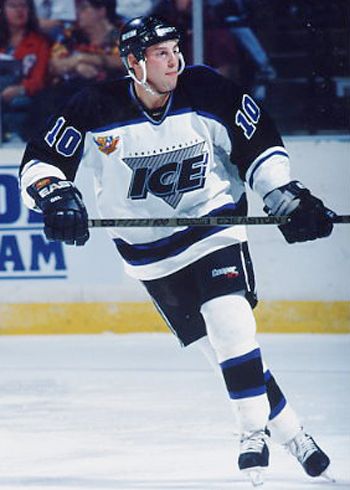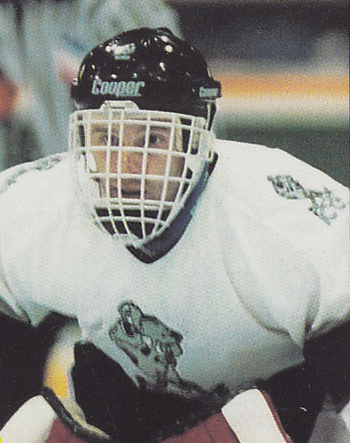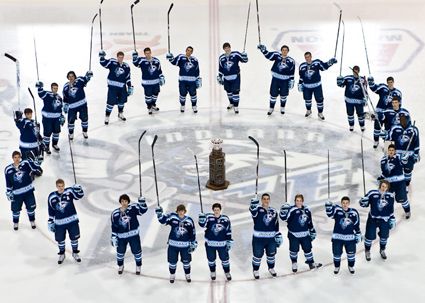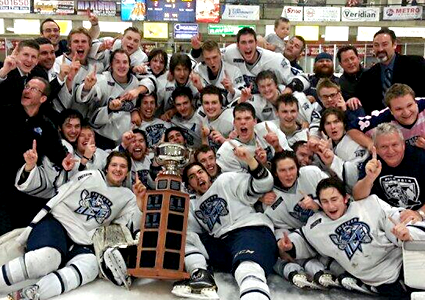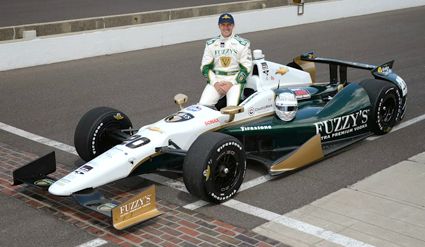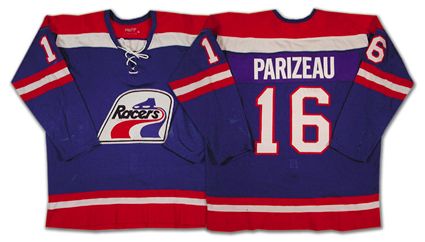Saturday, May 31, 2014
1932-33 Boston Bruins Tiny Thompson Jersey
Goaltender Cecil "Tiny" Thompson, born on this date in 1903, was the oldest of the two Thompson brothers, arriving three years before his brother Paul Thompson, who played left wing and became the first player to ever score a goal against his own brother!
Cecil's nickname "Tiny", acquired when he was still a teenager, was in jest, as he was the tallest player on the team at 5' 10".
Thompson's junior career began with the Calgary Monarchs in the 1919-20 season at the age of 16. As a 17-year-old, he played for the Calgary Pacific Grain club in the Calgary City Senior Hockey League. Back in junior hockey for 1921-22, he tended goal for the Bellevue Colts of the Alberta Junior Hockey League and remained in Bellevue for the next two seasons with the Bellevue Bulldogs of the Alberta Senior Hockey League.
The 1919-20 Calgary Monarchs
He moved to the United States to compete for the Duluth Hornets in the United States Amateur Hockey Association in 1924-25 before relocating a couple hours south to Minneapolis for the next three seasons to play for the Minneapolis Millers in the now renamed American Hockey Association. Thompson caught the eye of the NHL with his 1927-28 season with a stellar 28-7-5 record and a 1.23 goals against average.
His contract was purchased by Boston Bruins manager Art Ross, who had never actually seen Thompson play in person! He rewarded the Bruins faith with a 1-0 shutout in his first game as a Bruin in 1928. He played in all 44 of the Bruins games, winning 26, including 12 by shutout on his way to a 1.15 GAA. During the playoffs, Thompson recorded three shutouts in five games and allowed only three goals as the Bruins swept their way to the Stanley Cup title. When the Bruins reached the finals against the New York Rangers and Tiny's brother Paul, it was the first time that two siblings had met in the playoffs, something that would not happen again until the Esposito brothers 40 years later.
The Stanley Cup champion 1928-29 Boston Bruins
Scoring went up in the 1929-30 season when league rules were amended to allow for forward passing. While Thompson's GAA rose to 2.19 as a result of the more wide open game, he allowed the fewest goals of any netminder, earning him the first of his Vezina Trophies on his way to a stellar 38-5-1 record.
For the third consecutive season, Thompson played in all 44 of the Bruins games, winning 28 and lowering his GAA to under 2.00 again at 1.98. He was also involved in a unique strategy decision during that seasons playoffs, when, for the very first time in league history, Ross pulled Thompson late in Game 2 of the semifinals in favor of an extra attacker, instantly becoming a regular part of any coaches playbook.
The club had a down year in 1931-32, as they missed the playoffs and Thompson had his consecutive games streak stopped when he only played in 43 of the Bruins 48 games of the newly expanded schedule.
Thompson rebounded in 1932-33, winning 25 games and beginning a new streak of playing in every game, setting a career high with 48. His 1.76 GAA earned him his second Vezina Trophy while his most memorable game of the season came in the playoffs against the Toronto Maple Leafs, when the game moved to overtime tied at 0-0.
The extra time went on and on, finally reaching a sixth overtime when Ken Doraty of the Maple Leafs intercepted a pass and scored on Thompson after 104:46 of additional time in what was the longest game in NHL history at the time and is still the second longest game ever. The loss eliminated the Bruins from the playoffs and earned Thompson a standing ovation from the hockey-savvy Maple Leafs fans.
Three seasons later in 1935-36, Thompson set a new personal best GAA of the modern era at 1.68 on his way to this third Vezina Trophy and also became the first goaltender to ever be credited with an assist by intentionally passing the puck with his stick to a teammate.
The 1937-38 season again saw Thompson play in all 48 of the Bruins games, his sixth consecutive season playing each and every Bruins game. He won 30 or more games for only the second time in his career with a 30-11-7 record, which included 7 shutouts on his way to a 1.80 GAA and a fourth Vezina Trophy, the first man to ever win four.
With Thompson now 35 years old and future hall of famer Frank Brimsek waiting in the wings, Thompson was traded after five games of the 1938-39 season to the Detroit Red Wings. Thompson played in 39 games for Detroit that season and 46 the following season before retiring following the 1939-40 season.
He finished his NHL career with 553 games played, 284 wins, 194 losses, 75 ties, 81 shutouts, which was second all-time when he retired, a career GAA of 2.08, four Vezina Trophies and one Stanley Cup, won back in his rookie season of 1928-29.
Thompson was elected to the Hockey Hall of Fame in 1959.
Today's featured jersey is a 1932-33 Boston Bruins Tiny Thompson jersey. This was the first season for this style Bruins jersey after eight seasons with their original logo, which pictured a bear. The Bruins were still using their original colors of brown and yellow, which came from the club's original owner Charles Adams' grocery store chain, First National Stores.
This style, worn during the second of Thompson's four Vezina Trophy winning seasons, was used for two seasons until the club's permanent change to the colors black and yellow in 1934-35.
Labels:
Boston Bruins,
Thompson Tiny
Friday, May 30, 2014
1971-72 New York Rangers Gilles Villemure Jersey
After playing junior hockey with the Guelph Biltmore Mad Hatters of the Ontario Hockey League in 1959-60, goaltender Gilles Villemure, born on this date in 1940, joined the New York Rovers of the Eastern Hockey League for the 1960-61 season. He spent the next season with the Long Island Ducks, playing in 61 games that season.
He moved across the continent fir 1962-63 to become a member of the then minor league Vancouver Canucks of the Western Hockey League. There, Villemure posted his first winning record, going 35-31-4 in 70 games to win the WHL Rookie of the Year award.
He returned to the east coast for the 1963-64 season to play with the Baltimore Clippers of the American Hockey League as well as making his NHL debut with the New York Rangers, having been signed by the club back in 1962, but failed to impress, going 0-2-3 in five games played.
It was once more back across North America for the next two seasons, rejoining the WHL's Canucks for 1964-65 and 1965-66, being named a WHL First Team All-Star in 1966.
Back across the country yet again, he returned to Baltimore for the 1966-67 season, playing in 70 games with a 34-27-9 record. He was able to avoid the change in time zones for 1967-68 by becoming a member of the Buffalo Bisons of the AHL. He only saw action in 37 games for the Bisons, but had a winning record of 18-13-6 while posting the lowest goals against average of his career up to that point at 2.47. The highlight of his season was earning his first NHL victory during the four games he played with the Rangers that same season.
He really hit his stride the next two seasons with the Bisons, winning both the Hap Homes Award as the goalie with the lowest goals against average as well as the Les Cunningham Award as the AHL MVP in both 1969 and 1970. In the 1970 postseason, Villemure went 11-3 with a 2.13 GAA to lead the Bisons to the Calder Cup championship.
While the early part of his career was prior to the NHL expansion of 1967 when one goaltender played the majority, if not all of his teams games, the common thinking in the NHL had now evolved into favoring a two goalie rotation, creating a spot on the Rangers roster at long last. Paired with Eddie Giacomin on a strong Rangers club, Villemure played in 34 games in 1970-71 with a record of 22-8-4 and shared that season's Vezina Trophy with Giacomin.
He improved upon that mark in 1971-72, winning 24, setting an NHL career high, while losing just 7 and tying 4. He also made six playoff appearances with a 4-2 record as the Rangers made it to the 1972 Stanley Cup Finals.
The next season Villemure stayed on a roll, playing in 34 games with a record of 20-12-2 and also appeared in his third consecutive NHL All-Star Game. After playing in just 21 games in 1973-74, the popular Villemure rebounded with 45 appearances in 1974-75 and a 22-14-6 mark.
Now in his mid-30's thanks to his long minor league career, Villemure was traded to the Chicago Black Hawks for the final two seasons of his career where he saw limited action in a backup role to Tony Esposito before retiring after the 1976-77 season.
In all, Villemure played in 205 NHL games with a record of 100 wins, 64 losses and 29 ties and a career 2,81 goals against average.
Villemure remains a valued and respected member of the Rangers alumni, and is seen here pictured with current Rangers goaltender Henrik Lundqvist and his old goaltending partner Giacomin
Of note, during the offseason, Villemure was a professional harness race driver at horse racing tracks throughout the northeast.
"You need timing, you need quickness because when you live at the gate in harness racing, you have to time the gate, when you leave from behind the gate, if you have reflexes then you can get out of the gate quick," Villemure explained. "If you don't have the reflexes, then you lose a couple of steps and as a goaltender you need reflexes, of course. You have to make the right move at the right time."
Today's featured jersey is a 1971-72 New York Rangers Gilles Villemure jersey. While the Rangers had worn a variation of this white jersey since 1951-52, this jersey would only remain in use until the 1976-76 season until being replaced by a new modernized jersey that featured the Rangers shield logo rather than the diagonal "Rangers" cresting.
That new style would only last for two brief seasons before the return of the classic Rangers jerseys, which remain in use through this day, surviving the change to the Reebok Edge jerseys in 2007.
Today's video section begins with footage from a Rangers game against the Toronto Maple Leafs from 1970 which features Villemure versus Jacques Plante for Toronto.
Here is footage of a conversation with Villemure while he is signing reproductions of his instantly recognizable goalie mask.
Labels:
New York Rangers,
Villemure Gilles
Thursday, May 29, 2014
1992-93 Los Angeles Kings Wayne Gretzky Jersey
The Toronto Maple Leafs concluded the 1992-93 NHL season with 99 points and entered the playoffs as the third seed in the Norris Division, drawing the second seeded Detroit Red Wings in the first round of the playoffs. The series not only went the full seven games, but the final and deciding game in Detroit went to overtime before Toronto was able to advance to face the St. Louis Blues, who shocked the top seeded Chicago Blackhawks.
The scrappy Blues put up quite a fight, pushing the Maple Leafs to another Game 7 before Toronto was able to advance to the Campbell Conference Finals.
Meanwhile in the Smythe division, the Los Angeles Kings eliminated the favored Calgary Flames in six games before upsetting the top seeded Vancouver Canucks in six to earn a date with Toronto in one of the more memorable playoff series in league history.
The Maple Leafs, led by Doug Gilmour's 127 points, rugged captain Wendel Clark and the goaltending duo of rookie Felix Potvin and Grant Fuhr, were looking to play tight defensive hockey in hopes to return to the Stanley Cup Finals for the first time since winning the championship in 1967.
Meanwhile, the Kings, still looking to participate in their first finals in 1993, were led in scoring by Luc Robitaille's 63 goals and 125 points. Jari Kurri, Rob Blake and Wayne Gretzky also led the Kings attack. Gretzky had been limited to just 45 regular season games by a back injury and finished outside of the top three in league scoring for the first time in his career, but had fully recovered in time for the playoffs.
Kings coach Barry Melrose recalls the series "was one of the best series the NHL has had in the last 30 years. Both buildings were electric, and both cities were unbelievable."
Game 1 went to the Maple Leafs at home 4-1 but the tone for the series was set when the King's Marty McSorley destroyed Gilmour, who already had three points, with an elbow to the head and Clark went after McSorley in the kind of fight rarely seen in the playoffs.
The incident began a war of words in the media between Maple Leafs coach Pat Burns and the Kings Melrose after Burns accused Melrose of ordering the hit on Gilmour during the game, which got personal with Melrose commenting on Burns' weight and Burns comparing Melrose's mullet to that of country singer Billy Ray Cyrus.
The Kings were able to gain a split on the road with a 3-2 win and back in Los Angeles, they held serve in Game 3 with a 4-2 win only to lose two days later by the same score, sending the series back to Canada tied at 2-2.
In a tense Game 5, Toronto was able to put Los Angeles on the brink with a 3-2 win with 40 seconds remaining in overtime when Glenn Anderson scored by knocking a puck out of the air with an amazing backhanded swing.
Game 6 began with the Kings dominating the first two periods and holding a 4-1 lead in the third period before Clark exploded with a hat trick to force the game into overtime with under a minute and a half remaining in regulation.
Famously, a high sticking incident by Gretzky on Gilmour went uncalled and Robitaille fed the puck to Gretzky to win the game just 1:41 into overtime to force a deciding seventh game back at the historic Maple Leaf Gardens on this date in 1993.
Game 7 began with Grezky scoring shorthanded to put the Kings up 1-0 before assisting on Tomas Sandstrom's goal to give the Kings a 2-0 lead after one.
Clark and Anderson got the Maple Leafs even with goals in the first half of the second period before Gretzky struck again to beat Potvin with a slap shot to give the Kings a 3-2 lead heading in to the third.
Clark responded early in the third to even the game again at 3-3. Play continued up and down the ice until Mike Donnelly scored on a rebound of an Alexi Zhitnik shot to give the Kings the lead with less than four minutes remaining. Gretzky then completed his hat trick seconds later after circling the net and sending a backhander off the skate of a defender to give the Kings a two goal lead and little time remaining.
Before the Kings could breathe easy, Dave Ellett got one back for the Maple Leafs but when the dust settled, Toronto area native Gretzky had dismayed the home fans by setting a Stanley Cup record with his eight career playoff hat trick as the Kings prevailed 5-4 to advance to the Stanley Cup Finals for the first time in franchise history.
Today's featured jersey is a 1992-93 Los Angeles Kings Wayne Gretzky jersey. With the infamous trade of Gretzky to the Kings, a new era began for hockey in Los Angeles, which included the team's jerseys. Out was the garish gold and purple the team had worn since their inception in 1967 and in was a new black and white color scheme, popularized by the Los Angeles Raiders of the NFL.
While the jerseys did not change during their 10 year run, the customization of the Kings new jerseys evolved over time. The white jerseys originally had two color names and numbers in silver outlined in black for three seasons, followed by a change to three colors, silver trimmed in white and outlined in black for 1991-92.
For the 1992-93 season the numbers finally changed to a much easier to read black, which was trimmed in white and outlined in silver. Meanwhile, the hard to read three color names were simplified to one color black for the remainder of the jersey's run.
While the jerseys did not change during their 10 year run, the customization of the Kings new jerseys evolved over time. The white jerseys originally had two color names and numbers in silver outlined in black for three seasons, followed by a change to three colors, silver trimmed in white and outlined in black for 1991-92.
For the 1992-93 season the numbers finally changed to a much easier to read black, which was trimmed in white and outlined in silver. Meanwhile, the hard to read three color names were simplified to one color black for the remainder of the jersey's run.
All players wore the Stanley Cup Centennial patch on their jerseys in 1992-93, including the first three rounds of the playoffs. Once the two finalists were determined, the Kings and Canadiens then changed to the Stanley Cup Finals patch rather than the season long Centennial patch of today's featured jersey.
Bonus jersey: Today's bonus jersey is a 1992-93 Toronto Maple Leafs Doug Gilmour jersey as worn during the Maple Leafs memorable playoff series against the Kings.
Following the well received Turn Back the Clock jersey worn by Toronto for select games during the previous season of 1991-92 in honor of the NHL's 75th Anniversary, the Maple Leafs debuted a brand new jersey for the 1992-93 season, which featured a much more simple and classic style.
First up is a look at Game 1, which immediately set the tone for the series and the drama that was to follow.
Following the well received Turn Back the Clock jersey worn by Toronto for select games during the previous season of 1991-92 in honor of the NHL's 75th Anniversary, the Maple Leafs debuted a brand new jersey for the 1992-93 season, which featured a much more simple and classic style.
The twin white stripes on the arms and waist were first used by Toronto in 1934-35 and remained in use all the way through 1966-67. That basic jersey was paired with the Maple Leafs current, modern logo as well as the Turn Back the Clock jersey's retro style leaf logo as the new secondary shoulder logo.
First up is a look at Game 1, which immediately set the tone for the series and the drama that was to follow.
Here is Don Cherry reacting to the non-call on Gretzky in overtime of Game 6, followed by NHL official Bryan Lewis to explain the call.
Finally, a brief look back at the entire series.
Wednesday, May 28, 2014
1931-32 Toronto Maple Leafs Red Horner Jersey
Bruising Hall of Fame defenseman George "Red" Horner was born on this date in 1909. He began his hockey career with the Toronto Marlboros of the Ontario Hockey Association in 1926-27, the first of two seasons he would play with the junior club.
Horner's rise to the NHL in 1928 must have set some sort of record, as he played for the junior Marlboros on the evening of Friday, December 21st. The next afternoon he suited up for an amateur team in the stock brokers league, as his day job was as a clerk at a brokerage at the time, and was informed after the game by team owner Conn Smythe, who was in attendance at the amateur game, that he would be suiting up for the Toronto Maple Leafs that evening for their game against the Pittsburgh Pirates, his third game at three different levels in 24 hours!
Unfortunately, Horner broke his hand in his second game which limited him to just 22 games that season. He gave a glimpse of what was to come however, as he was assessed with 30 minutes in penalties that season.
Horner in a Maple Leafs sweater worn from 1927 to 1934
The next season he played in 33 games, which included his first NHL points with a pair of goals and 7 assists to go along with his 96 penalty minutes.
Two seasons later in 1931-32 Horner competed in 42 games and more than doubled his career goal totals up to that point when he found the back of the net 7 times and established a new high in points as well with 16. He was also in the starting lineup on November 12, 1931 when the brand new Maple Leaf Gardens hosted it's first game.
The Maple Leafs advanced to the playoffs that season where they defeated the Chicago Black Hawks 6 goals to 2 in their two-game total-goal series. They advanced to the finals by defeating the Montreal Maroons 4 goals to 3. The Maple Leafs then swept the New York Rangers in three straight games, scoring 6 goals in each contest to win the only Stanley Cup of Horner's career. Horner contributed 2 goals and 4 points in the Maple Leafs 7 playoff games.
The 1932 Stanley Cup champion Toronto Maple Leafs
By the 1932-33 season, Horner had now grown into a man's body and became an even more physical player. He surpassed the 100 penalty minute mark with 144 to lead the league for the first of eight consecutive seasons. In 1933-34 Horner raised his penalty minute total to 146 and set a career high with 11 goals and a new personal best of 21 points.
The 1935-36 season saw Horner break the eight year old league record for penalty minutes held by the legendary Eddie Shore when he was whistled for 167.
Horner with a teammate in the sweaters worn from 1934 to 1937
Two seasons later in 1937-38 Horner set a a career best with 24 points from 4 goals and 24 assists while continuing his streak of leading the league in time in the box.
He was named team captain in 1938 and would play two more seasons for the Maple Leafs before retiring after the 1939-40 season with 490 games played, 42 goals and 110 assists for 152 points and 1,264 career penalty minutes, which was the most in league history and a mark which stood until 1958 until broken by Ted Lindsay. His record of leading the league in penalty minutes for eight straight seasons still stands to this day.
Horner in a Maple Leafs sweater worn from 1938 to the end of his career
During his playing days Horner had the honor of playing in both the 1934 Ace Bailey Benefit Game and the 1937 Howie Morenz Benefit Game, two early All-Star contests that pre-dated the now annual NHL All-Star Game.
Horner was elected to the Hockey Hall of Fame in 1965.
Today's featured jersey is a 1931-32 Toronto Maple Leafs "Red" Horner jersey. The club was renamed the Maple Leafs in the middle of the 1926-27 season after being purchased by Smythe. Their original jerseys were a plain white sweater with a green Maple Leaf, which changed to blue at the start of the 1927-28 season.
They also introduced an early version of today's featured jersey with it's multiple arm and waist stripes as their primary sweater that season, adding the white shoulder striping for the 1930-31 season. This is the style Horner and the Maple Leafs wore when they captured the Stanley Cup in 1932.
Additionally, today's featured jersey was the basis for the throwback style the Maple Leafs wore for the 2014 NHL Winter Classic. While very similar, there were a few differences, such as the lace-up collar, the addition of modern sleeve numbers and player names on the back as well as the fact the numbers were one color white rather than the original two color blue numbers with white outlines worm back in the 1930's. While not an identical copy of the originals, the Winter Classic jerseys were very well received and looked great in action.
Today's video is about the 1932 Stanley Cup champion Toronto Maple Leafs.
Today's video is about the 1932 Stanley Cup champion Toronto Maple Leafs.
Labels:
Horner Red,
Toronto Maple Leafs
Tuesday, May 27, 2014
2010-11 Krefeld Penguins Herberts Vasiljevs jersey
A true stalwart of the Latvia National Team, Herberts Vasiljevs was born on this date in 1976 in Riga, Latvia.
His professional career began with the Krefeld Penguins of the German DEL in the 1994-95 season as an 18-year-old.
Vasiljevs came to North America the following season and the right winger had a strong season for the Guelph Storm, scoring 34 goals and 67 points in 85 games. Guelph made it to the Memorial Cup and Vasiljevs contributed 19 points in 16 games.
The 1996-97 season saw him visit the hockey outposts of Knoxville of the ECHL and Port Huron of the Colonial Hockey League for 3 games each although he spent the majority of the season with the Carolina Monarchs of the AHL. On the move once again for 1997-98, he finished third in scoring for the New Haven Beast of the AHL with 66 points in 76 games.
Continuing his travels around the minors, Vasiljevs played for the Kentucky Thoroughblades in 1998-99, averaging a point per game with 76 points in 76 games. He also made his NHL debut that season with 5 games with the Florida Panthers, but failed to score a point.
1999-00 was a similar story for the Latvian, as the majority of his season was again spent in the AHL, this time with the Orlando Solar Bears, playing 73 games and scoring 60 points while seeing action in 7 NHL games with the Atlanta Thrashers, which included his first NHL goal.
He was back with the Solar Bears for 58 games, scoring over 20 goals for the fourth consecutive AHL season with 22 in addition to his 21 games spent with the Thrashers during which he scored 4 goals and 5 assists.
The 2001-02 season saw a change in organizations, as he split time between the Vancouver Canucks for 18 games and their top minor league affiliate, the Manitoba Moose for 31 games.
It proved to be the final NHL games of his career, as he spent the entirety of the 2002-03 season with Manitoba, which in turn were the final games of the North American portion of his career, as Vasiljevs signed with Khabarovsk Amur of the Russian Elite League for 2003-04.
Vasiljevs returned to Germany the following season with the Nuermberg Ice Tigers where he regained his scoring touch with 38 points in 39 games, his highest average per game since 1999.
After 11 seasons of bouncing around from country to country, from the minors to the pros, Vasiljevs found a home - right back where he started in 1994 with Krefeld as an 18-year-old.
At the conclusion of this past 2013-14 season, Vasiljevs, now the captain of the Penguins since 2007, has now played for Krefeld for the last nine seasons, leading the team in scoring in 2007, 2008, 2010 and 2011. He also been a regular fixture in the top ten in league scoring since 2006-07 when he led the DEL in goal scoring with 30 goals and was named the DEL league MVP.
While Vasiljevs club teams were an unsettled lot for the first decade of his career, his place on the Latvia National Team was not. He made his first appearance for his country in 1998 at the World Championships. He made three more World Championship appearances in 2000, 2004 and 2005. A busy 2006 saw him make his Olympic debut in February, scoring his first international goal, followed by a highlight for all Latvians, as they hosted the World Championships for the first time in May.
Photo courtesy of Francis Larrede © 2010
He continued his international career, which included becoming a captain of the national team, with consecutive World Championship appearances from 2007 to 2011 including leading the team in scoring in 2009. While he was limited to just 11 games with Krefeld in the DEL this season, Vasilievs played in his third Olympics this year as well as playing in his 11th World Championships for Latvia. After a slow start with 5 points in his first six international tournaments, Vasiljevs has now scored 27 points in his last seven.
Today's featured jersey is a 2010-11 Krefeld Penguins Herberts Vasiljevs jersey. This jersey is typical of many European league jerseys with it's numerous sponsorship patches and use of dye-sublimation allows for the use of especially bright colors and gradient on the shield of the main crest..
Bonus Jersey: Today's bonus jersey is a 2001-02 Manitoba Moose Herberts Vasiljevs jersey as worn during the North American portion of Vasiljevs career while he was trying to become an NHL regular. With their use of the moose antler theme, Manitoba's jerseys have some of the greatest numbers in the history of hockey jerseys.
In today's video segment, Vasiljevs scores in the 2009 World Championships for Latvia. Goals by Latvia against Russia are particularly sweet for the team and their fans taking into account their past political situation.
Sunday, May 25, 2014
The History of Hockey in Indianapolis
With today being the annual running of the Indianapolis 500, we thought it would be an appropriate day to take a look at the history of hockey in Indianapolis.
Today's race will be paced for the second consecutive year by fastest qualifier and Indianapolis native Ed Carpenter, who flew around the track for an average of 231.016 mph, 2.25 mph faster than his pole speed of last year.
Finally, an Indy 500 tradition that comes to an end this year, Jim Nabors singing "Back Home Again in Indiana", something he has done almost every year since 1972.
The oldest team we could find information about is the Indianapolis Capitals of the American Hockey League who began play in the 1939-40 season. The Capitals, who were a farm team for the Detroit Red Wings, started out strong, winning their division in their very first season and two seasons later, after posting a 34-15-7 regular season record went on to capture the Calder Cup as league playoff champions in 1942.
A look at the uniforms of the Indianapolis Captials
They would return to the finals in 1943 but it would take eight years for the Capitals to again win the Calder Cup following a sweep of the Cleveland Barons in 1950. The club, which played it's games at the Indiana State Fair Coliseum, lasted through the 1951-52 season. Les Douglas was the franchise's leading scorer, with 302 points in six seasons in Indianapolis. The most well known player for the Capitals was Terry Sawchuk, who spent two seasons tending goal before joining the Red Wings for a Hall of Fame career.
The next team to call Indianapolis home was the Indianapolis Chiefs of the International Hockey League from 1955-56 to 1961-62. They also called the coliseum home and started out poorly with an 11-48-1 record. They improved quite a bit in year two, but still finished under .500 at 26-29-5. The next season they again had a losing record (28-30-6), but came to life during the playoffs, eventually becoming the 1958 Turner Cup champions by outlasting the Louisville Rebels 4-3 in the finals. The club would last four more seasons and never manage a single winning record during their eight seasons of existence.
The 1956-57 Indianapolis Chiefs
The next attempt at a hockey team in Indianapolis was extraordinarily brief, as the team, also named the Indianapolis Capitals but playing in the Central Hockey League this time around, had played nine games of their inaugural season when a gas explosion during an ice show killed 74 people and heavily damaged the coliseum, causing their parent club, again the Red Wings, to move the franchise to Cincinnati for the remainder of the season.
Indianapolis went without a team for the next nine years until the arrival of the first major league team in the city's history in the form of the Indianapolis Racers of the World Hockey Association in 1974-75. The Racers, the first team to embrace the racing heritage of the city, played their games in the brand new 16,000 seat Market Square Arena.
The Racers had a rough start as well, winning 18 and losing 57 with 3 ties their first season in the then 14 team WHA. They bounced back nicely in year two, winning their division, although with a 35-39-6 mark. The following year they won their first playoff series but found the going much tougher in 1977-78, falling to last place in the now 8 team league and missing the playoffs.
Desperately trying to survive, owner Nelson Skalbania signed the then 17-year-old Wayne Gretzky to play for the Racers. The arrangement would only last eight games before Skalbania sold Gretzky to the Edmonton Oilers. It was a death blow for the Racers, who lasted just 15 more games before folding after just 25 games and a dismal 5-18-2 record on December 15, 1978. Like the Chiefs, the Racers never posted a winning record in their four plus seasons.
Wayne Gretzky during his time with the Racers
Other than Gretzky, Mark Messier had a five game cameo with the Racers and Dave Keon played 12 games in Indianapolis.
The Indianapolis Checkers, which suggested both "a check" in hockey as well as "a checkered flag" in racing, arrived the following season of 1979-80 as members of the Central Hockey League and played out of the coliseum. They provided the city with their first winning record since the 1950-51 Capitals when they began life with a 40-32-7 mark in their debut season. Two seasons later they improved upon that feat by winning the Adams Cup as champions of the CHL. They brought the fifth championship to Indianapolis when they went back-to-back by winning the title again in 1983 after a league best 50-28-2 record. After one more season in the CHL, down to just five clubs, folded. Long time Vancouver Canucks Goaltender Richard Brodeur and future New York Islander and Los Angeles Kings netminder Kelly Hrudey were the best known of the CHL era Checkers.
The Checkers receiving the 1982 Adams Cup
The Checkers lived on however, as they joined the same IHL the Chiefs once belonged to for the 1984-85 season. The IHL was a step up from the CHL and the Checkers lasted three more seasons before relocating to Denver after the 1986-87 season.
After one season without professional hockey in the city, the Indianapolis Ice arrived in the 1988-89 season and began life at the coliseum, but had enough success to move to the larger Market Square Arena. Typically, the expansion club began slowly with a 26-54-2 record but immediately turned things around in their second season, going 53-21-8 to win the Western Division before storming through the playoffs with a 12-2 record to return the Turner Cup to Indianapolis for the first time since the Chiefs won it back in 1958, a gap of 32 years.
Steve Dubinksy of the Indianapolis Ice in the 1994-95 season
They were never able to repeat their championship success over the next nine seasons, but did have five winning seasons and two division titles in their 11 year run in the IHL. The Ice were affiliated with the Chicago Blackhawks, and therefore had the services of none other than Dominik Hasek for parts of two seasons upon his arrival in North America.
Dominik Hasek while a member of the Ice
After the 1998-99 season, the Ice left the struggling IHL, which lasted only two more seasons, and gained membership in the Central Hockey League, only a different CHL than the one the ill-fated 1963-64 Capitals were members of. The Ice won the Miron Cup as champions of the CHL the first time out. They continued to play for four more seasons before folding after the 2003-04 season, bringing to and end professional hockey in Indianapolis for the time being.
The 2000 Miron Cup champion Indianapolis Ice
While the IHL Ice were active, there was also an Indianapolis Junior Ice that played Junior A hockey in the North American Hockey League from 1989-90 to 1994-95.
Another Junior A club named the Indiana Ice began play in the United States Hockey League in 2004 following the demise of the Ice of the CHL. They too, play at the Indiana State Fairgrounds in the now renamed Pepsi Coliseum, which has been home to nearly every major hockey team in Indianapolis hockey history, dating all the way back to the original Capitals in 1939.
Following their first three sub .500 seasons, the Ice won the Eastern Division of the USHL in 2007-08 and became the Clark Cup champions in 2008-09, the fifth team from Indianapolis to win a championships for the city represented by five different trophies - the Calder, Turner, Adams, Miron and Clark!
The Indiana Ice pose with the Clark Cup in 2008
Just five days ago, on May 20, 2014, the Ice captured their second Clark Cup as USHL champions, the ninth title for the city of Indianapolis.
One virtual constant throughout the history of hockey in the city of Indianapolis has been the Indiana State Fair Coliseum, now known as the Pepsi Coliseum, which opened in 1939, which also saw the arrival of the Indianapolis Capitals. It seats 8,200 fans. In addition to all the various hockey teams who have called the Coliseum home, it has also hosted the Indiana Pacers basketball team while they were members of the ABA from 1967 to 1974, which included league titles in 1970, 1972 and 1973.
The Indiana Ice celebrate their second Clark Cup in 2014
One virtual constant throughout the history of hockey in the city of Indianapolis has been the Indiana State Fair Coliseum, now known as the Pepsi Coliseum, which opened in 1939, which also saw the arrival of the Indianapolis Capitals. It seats 8,200 fans. In addition to all the various hockey teams who have called the Coliseum home, it has also hosted the Indiana Pacers basketball team while they were members of the ABA from 1967 to 1974, which included league titles in 1970, 1972 and 1973.
It has also hosted boxing cards, boat and sports shows, horse shows, graduation ceremonies and concerts, which include such acts as The Beatles, Rolling Stones, Jimi Hendrix, Led Zeppelin and The Who.
The Indiana State Fair Coliseum
Today's race will be paced for the second consecutive year by fastest qualifier and Indianapolis native Ed Carpenter, who flew around the track for an average of 231.016 mph, 2.25 mph faster than his pole speed of last year.
Today's featured jersey is a 1977-78 Indianapolis Racers Michel Parizeau jersey from the first Indianapolis team to embrace the heritage of the Indianapolis 500 in their identity package.
The Racers wore the same jerseys for each of their five seasons, the last two changing from two color names to one color names on the back and this jersey has the distinction of being Wayne Gretzky's first professional jersey.
Parizeau never led the club in scoring, but through his longevity of the ever-evolving roster was the Racers all-time leader in points, with 136 during his four seasons with the Racers. Parizeau played with both the St. Louis Blues and Philadelphia Flyers in 1971-72, scoring 3 goals in 58 total games. He then joined the Quebec Nordiques of the brand new WHA in 1972 and reeled off four seasons of 25 goals or more, including a change from the Nordiques to the Racers in 1975-76. In 509 WHA games, Parizeau scored 142 goals and 394 points.
Bonus jersey: Today's bonus jersey is a 1978-79 Indianapolis Racers Michel Parizeau jersey from the Racers final season. In fact, the Racers did not make it to 1979, folding after just 25 games of the season on December 17, 1978 with a record of 5-18-2, having sold Gretzky after just eight games of the schedule.
Today's video section begins with highlights of the Indianapolis Racers from 1974 to 1979.
photos courtesy of Classic Auctions
Today's video section begins with highlights of the Indianapolis Racers from 1974 to 1979.
Perhaps the most significant moment in Indianapolis hockey history, Wayne Gretzky's first professional goal as a member of the Racers.
Up next is the Indiana Ice winning the 2014 Clark Cup, the most recent of nine championships for hockey teams to call Indianapolis home.
Finally, an Indy 500 tradition that comes to an end this year, Jim Nabors singing "Back Home Again in Indiana", something he has done almost every year since 1972.
Subscribe to:
Comments (Atom)

